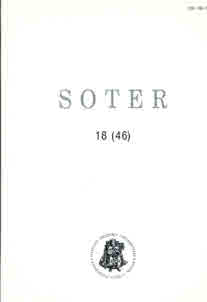Olivier Messiaeno religinių pažiūrų kūrybinės intencijos
The creative intentions of Olivier Messiaen religion outlooks
Author(s): Milda KazakevičienėSubject(s): Christian Theology and Religion
Published by: Vytauto Didžiojo Universitetas
Keywords: kompozitorius; religinė pasaulėžiūra; bažnytinė muzika; kūriniai; muzikos raiška; Dievas; Biblija; krikščioniškas tikėjimas; modalinė harmonija; sakralinė muzika; paukščių giesmės; Messiaen; composer; religion outlook; church music; works;
Summary/Abstract: Olivier Messiaen (b. 1908, d. 1992) is a composer who stands alone in the history of music. He formed and created his own totally individual music style, coming not from any particular school or style. He was, taking rhythmic ideas from India (deci tala), ancient Greece and the old Orient countries. Messiaen spent a great deal of time in the study of its rhythmic elements and their possible uses, as well as to clarify their symbolism. His “added value” technique (adding the same duration to each element of a rhytm) is an example of constant augmentation. It was applying these methods that O. Messiaen came across the nonretrogradable rhythms which play a very important part in his works. The composer studied western rhythms, most importantly, I. Stravinsky and C. Debussy. Messiaen’s harmony is equally individual: combines tonality, atonality, modality and serialism. Central to Messiaen’s harmonic technique are the “modes of limited transposition”. His concept of colour is completely unique. Messiaen has often stated that he sees colours when writing or listening music. He composes sounds just as a painter mixes his colours, and he is aware of the importance of both instrumentation and harmonic structure in producing his colours. His technique gives Messiaen’s writing for the piano a completely new range of colour, “a rainbow”, as he calls it. The functional aspect of timbre in Messiaen’s music is most important. He used timbre for essential structural purposes: tone – colour is as important as pitch and duration. Composer’s early works showed an inkling of birdsong influence but after the II World war in the late 40s and 50s he began notating their songs in great detail and it became a musical source for him. The birdsong is usually combined with the birds habitant surroundings and time of day. He became an authoritative ornithologist able to recognize almost any bird that he heard. O. Messiaen was a man of many interests, besides music including painting, literature, and the orient, where he took musical culture, theatre, literature and even the cuisine of foreign countries. Messiaen entered the Paris national Conservatoire when he was eleven. He studied harmony, counterpoint and fugue (premier prix in 1926), piano accompaniment (premier prix in 1928), the history of music (premier prix in 1929) and composition (premier prix in 1930). Messiaen’s professors were M. Dupre improvisation and organ), M. Emmanuel (history of music) and P. Dukas (composition). After finishing his studies, Messiaen became the principal organist at “La Trinite” in Paris and remain there until his death. In 1947 he was appointed to teach a course of musical analysis at the Paris Conservatoire, in 1966 Messiaen became the professor of composition.His music may be divided into a four periods: 1) religion (up to the “Harawi” song; 2) “exotic” (1945–1949); 3) the “birdsong” (1951–1958); 4) “synthesis”, last period.
Journal: SOTER: religijos mokslo žurnalas
- Issue Year: 47/2006
- Issue No: 19
- Page Range: 119-136
- Page Count: 18
- Language: Lithuanian

